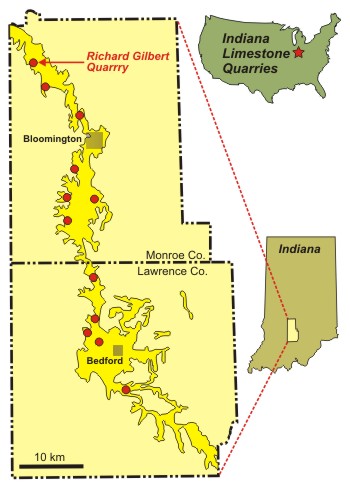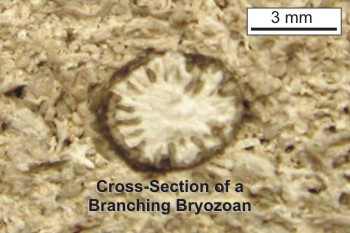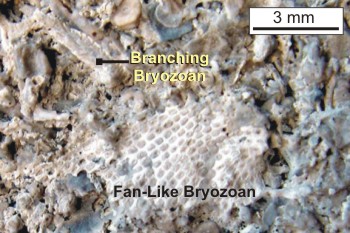
GE Building (Rockefeller Center)
|
INDIANA
LIMESTONE
|
 |
|
| Official Name: | Salem Formation | |
| Location: | Monroe and Lawrence counties, Indiana | |
| Age: | Middle Mississippian (335-340 Ma) | |
| Lithology: | Limestone (Calcarenite/Grainstone/Biosparite) | |
| NYC Examples: | Empire
State Building, Flatiron Building, GE Building (Rockefeller Center) |
|
 |
The Salem Formation (a.k.a. Indiana Limestone) crops out along a thin, irregular arcuate band in south-central Indiana (Monroe and Lawrence counties). Most quarries lie between the cities of Bloomington and Bedford. Quarrying of Indiana Limestone began in 1827 with the opening of the Richard Gilbert Quarry. The quarried stone was produced for local use only prior to the building of railways in the 1850's. However, by 1900, Indiana limestone represented 1/3 of the total U.S. dimension limestone industry, and increased to 80% by 1920. There are currently 9 active quarries that produce 76,000 cubic meters of Indiana Limestone each year. The limestone is soft and easily worked when quarried, but once the quarried rock dries it becomes case-hardened, that is, its surface becomes harder and more resistant to weathering. Indiana Limestone is a freestone, which means that it has no preferential direction of splitting. It can be planed, turned on a lathe, sawed, and hand worked, making it highly versatile. |
||||
|
Where quarried, the Salem Formation varies from 8 to 18 meters (25 to 60 feet) in thickness, and is unusually massive (i.e., lacks partings and stylolites). For a rock, the Indiana Limestone is chemically pure and consistent, being composed of >97% calcite. The combination of these physical and chemical characteristics make the Indiana Limestone well-suited to building because:
|
Chemical
Composition
of Indiana Limestone (www.bcausa.com/teclime.html) |
|||
|
CaCO3
|
97.3%
|
|
||
|
MgCO3
|
0.4%
|
|
||
|
Al2O3
|
0.5%
|
|
||
| SiO2 | 1.7% | |||
|
|
|
|
||
|
GEOLOGICAL FEATURES OF THE INDIANA LIMESTONE The building stone quarried from the Salem Formation consists of light-grey to bluish-grey limestone (calcarenite) that has oxidized locally to a light tan. It is medium to coarse grained, well sorted, and porous. It consists mostly of small fossils and fossil fragments. |
|
| The most abundant fossil is the foraminiferid Endothyra baileyi that is up to 1 mm in length. Foraminifera (forams for short) are marine single-celled protists with shells that are commonly divided into chambers which are added during growth. Endorytha appears as small, simple, smooth, ellipsoidal grains. The complex, chambered structure of its shell (or test) is apparent only under the microscope. | |
| Fragments of bryozoans are also common in the Salem Formation. Bryozoans are tiny aquatic organisms (rarely larger than a millimeter) that live in colonies of interconnected individuals. Some bryozoans encrust hard surfaces such as rocks or shells. Other bryozoans formed tree-like branching colonies. The most abundant bryozoans in the Indiana Limestone formed fan-like colonies that left behind lacy, net-textures fossils. Each window-like hole in the net once housed an individual bryozoan animal. "Fenestra" is latin for "window", and so this type of organism is refered to as a fenestrate bryozoan. | |
 |
 |
|
Other fossils grains that can be found commonly in the Indiana Limestone include:
|
 |
 |
 |
|
Larger-scale sedimentary
features that are commonly found in blocks of Indiana Limestone, include
cross-bedding, and sinuous trace fossils on bedding planes. |
|
|
|
|
|
ENVIRONMENT OF FORMATION During the Middle to Late Missisippian (335-340 million years ago), most of what is now the USA was covered by shallow seas that straddled the equator. Limestone accumulated on the seafloor below these warm, tropical waters. The Indiana Limestone formed far enough offshore that very little continentally-derived siliciclastic sediment was available to mix with the carbonate sediment that was forming in the immediate area. Despite being 10's to 100's of kilometers offshore, the water was shallow enough for waves to move coarse carbonate sand across the seafloor. The constant wave action washed away the smallest particles, whereas the larger fossils were battered and broken. The result was a rock consisting of well sorted grains that consist of small fossils and fossil fragments. |
Image
adapted from: |
| Like modern-day fan corals, fan-like fenestrate bryozoans lived in quiet, low energy environments. Thus the abundant fragments of these fossils must have been transported from their original setting, but could not have been moved too far or else these delicate fossil fragments would have been completely destroyed. | |
© 2004 Wayne G. Powell